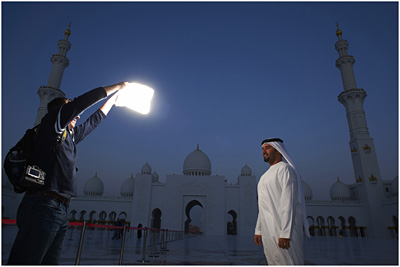Lighting 101: Pre-Visualizing Your Light

The big problem with flash is that for many photographers it is a leap of faith. It happens so fast you can't really see it — or what it's doing. Continuous light is so much more comfortable, because we can observe it real-time.
One workaround for this is to use a big, heavy expensive flash with a "modeling" light built in. The modeling light mimics the much more powerful flash (same location as the attached flash) and shows you what the flash will illuminate, and how.
I am going to try to talk you out of that, to start. Why? Because flashes with modeling lights are bigger and more expensive. And either they have to plug into the wall or they need pretty heavy batteries.
And besides, with a little experimenting you'll find you don't need that crutch of a modeling light. Here's why.
You know what hard light looks like. Sunny day. You know what soft light looks like. Cloudy day. You already have a lot more intuition about light than you think. You just have to hone it a little, as we talked about in the last post about reverse-engineering others' lighting.
It's the same thing; we are just approaching it from the opposite direction. You are trying to visualize what your light will look like (i.e., what it will illuminate) before the fact, not after.
You'll want to know things like, a) where will the light fall, and b) will there be reflections?
Reflections are pretty easy. Light works like a pool shot. Light will reflect off of a subject at the same angle (but in opposite direction) that it struck.
That is why we learned to light eyeglass wearers at an oblique angle. The reflections are still there. They are just diverted to bounce harmlessly away from the camera viewing angle.
You can also pop the flash and "eyeball" the scene - especially shiny or glass areas - to check for reflections, too. Just make sure you are looking from the same position from which you will be shooting.
It is easier than you think. Try it.
Now, where will the light fall? What will be illuminated? That one is different, and is the main reason most people use modeling lights. And there is a really easy workaround to this question.
You are already used to walking around a looking at your scene from a few different points of view to choose your camera angle. (You should be, anyway.)
You need to get in the habit of doing this with your light, too. A good time to do it is while you are setting up your lights. Simply view the subject from the position of your light.
When you are looking at the scene from your light's position, you see exactly what the light will see. Makes sense, right? And with a little practice, this will eliminate your need for a modeling light.
It is a very fast procedure. Especially if you are folding the process into that of setting up the lights.
I know it may sound a little weird. But just try it.
Next: It's Not (All) About Flash
__________
New to Strobist? Start here | Or jump right to Lighting 101
My new book: The Traveling Photograher's Manifesto
Permalink
<< Home